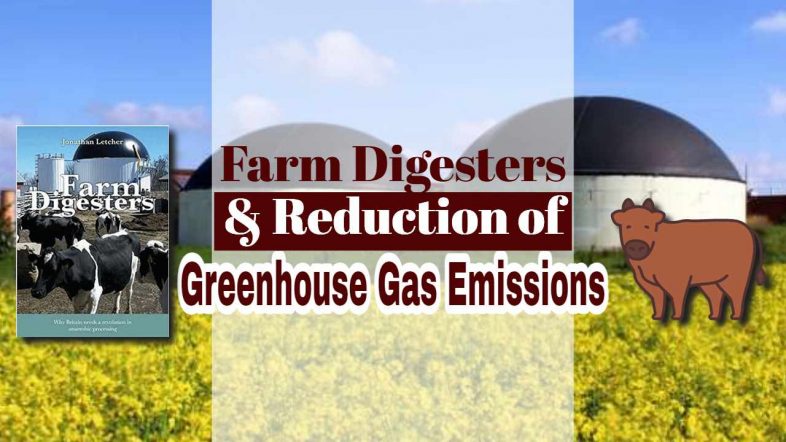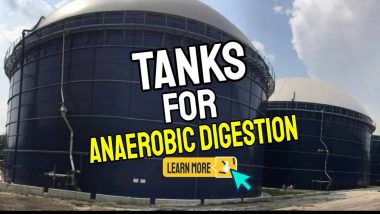In this article, we discuss Farm Digesters and the Role of Biogas in the Reduction of Greenhouse Gas Emissions.
Farming waste is piling up, and greenhouse gases like methane are heating the planet faster than we can handle. For many farmers, managing animal waste or food scraps feels overwhelming.
At the same time, rising costs of energy and fertilisers strain their budgets. The challenges are real.
Farm digesters offer a smart way forward. These systems turn organic waste into biogas energy and nutrient-rich fertiliser while cutting down on harmful emissions like methane. This blog explores how farm digesters work, their benefits for agriculture, and why they matter in the fight against climate change.
Ready to learn more? Keep reading!
Key Takeaways
- Farm digesters cut methane emissions by up to 80%, turning farm waste into biogas, renewable energy, and natural fertiliser.
- Common types include complete mix digesters (CSTRs), covered lagoons, and plug flow systems, fitting different farms and waste types.
- Digestate from farm digesters replaces synthetic fertilisers, reducing nitrous oxide emissions while improving soil health.
- Farmers save on waste disposal costs and earn income by selling energy back to the grid through renewable sources like biogas.
- UK policies offer subsidies under carbon capture schemes to encourage digester use for cleaner farming practices.

Farm Digesters and Greenhouse Gas Reduction
Farm digesters turn waste into biogas, cutting harmful emissions. These systems tame methane from manure while producing clean energy.
What are the benefits of using farm digesters?
Farm digesters cut methane emissions by up to 80%, helping combat climate change. They turn waste, like manure and food waste, into clean energy such as biogas or biomethane. This reduces the need for non-renewable energy sources.
Odour control improves thanks to anaerobic digestion, making farms neighbour-friendly. Digestate from these systems becomes a natural fertiliser, boosting soil health and slashing chemical use.
As if that’s not enough, they generate electricity too!
One farm digester can turn livestock waste into renewable heat while managing odours efficiently.
What are the common types of digester system technologies?
These systems transform waste into biogas through anaerobic digestion. Many farms use complete mix digesters (CSTRs). These tanks stir manure constantly, producing steady biogas output.
They suit farms with liquid or slurried waste.
Covered lagoons offer another option. Large pits covered with flexible lids trap methane gas from manure breakdown. They work well in warm climates and are cost-effective for dairy farms or hog farms.
Plug flow systems fit dairies handling thick manure. Waste moves in a straight line through a long tank, breaking down naturally over time. Each technology fits certain farm types and waste conditions, maximising efficiency and renewable energy production like compressed natural gas or electricity generation.

Components of Farm Digesters
Farm digesters rely on key parts like storage tanks, pumps, and ventilation systems for smooth operation. Regular care keeps these machines running well and producing clean energy.
How should routine checks and maintenance be performed?
Clear access to all parts of the anaerobic digester is vital. Inspect storage tanks, pumps, and ventilation systems regularly for leaks or blockages. Check safety valves on boilers daily to avoid pressure build-up.
Manure management equipment like separators should stay clean and operational.
Keep an eye on gas meters and engine generators weekly to prevent malfunctions during biogas production. Chillers, heaters, and other temperature control tools need frequent calibration to remain efficient.
As they say, “A stitch in time saves nine.
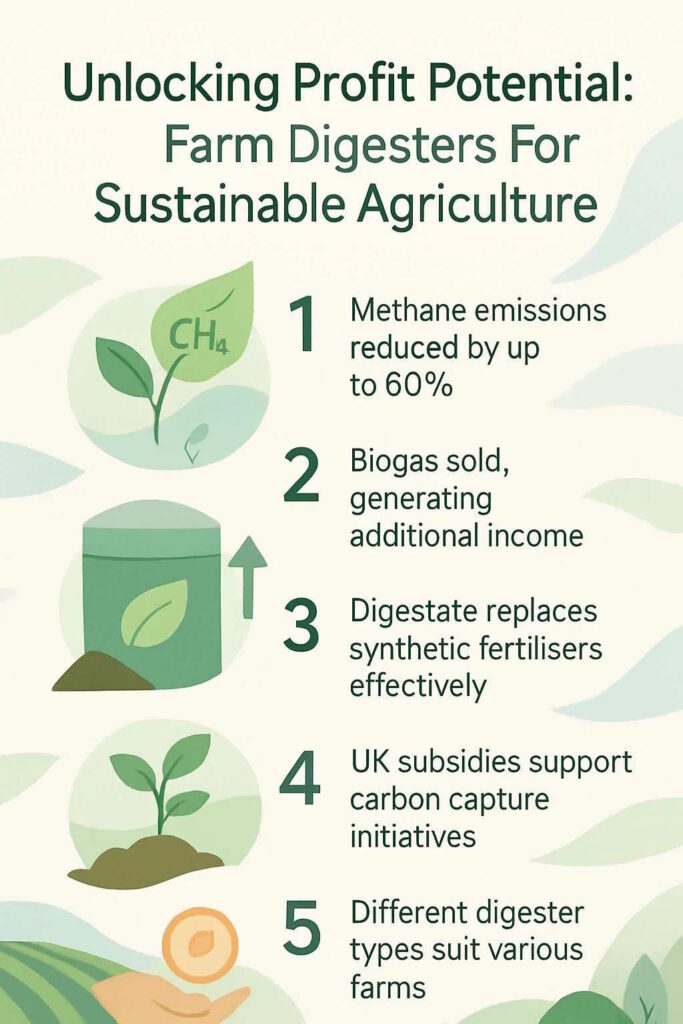
Agricultural Methane Emissions
Methane from farms is a big problem, but smart strategies and digester technology can turn this gas into clean energy—read on to see how!
What strategies reduce agricultural methane emissions?
Farmers can slash methane emissions by capturing gas from stored manure. Using anaerobic digesters processes this waste, converting harmful gases into green energy like biofuels or renewable natural gas.
This reduces pollution and creates sustainable farming solutions.
Improved livestock feeding also helps. Adding additives like fats or oils to cattle feed cuts down emissions during digestion. Storing slurry in covered systems stops methane from escaping too.
These methods save money, improve waste management, and align with net zero goals for agriculture.

How does anaerobic digestion reduce methane?
Treating livestock waste in anaerobic digesters stops methane from escaping into the air. That happens all the time when farm slurry is stored in lagoons. By using the anaerobic digestion process, the waste decomposes in a closed system, blocking gas leaks. By capturing methane and using it as biogas for energy, emissions drop by up to 80%.
This process also reduces the need for fossil fuels.
Energy crops have less impact compared to processing manure or food waste. Digesters handle an increasingly wide range of biodegradable materials like dairy farm slurry, food scraps, and municipal wastewater more efficiently.
Without treatment, these release harmful greenhouse gases when left in lagoons or landfills.
Carbon Emissions Comparison
Farm digesters slash greenhouse gases, making farms cleaner and greener—read on to see how.
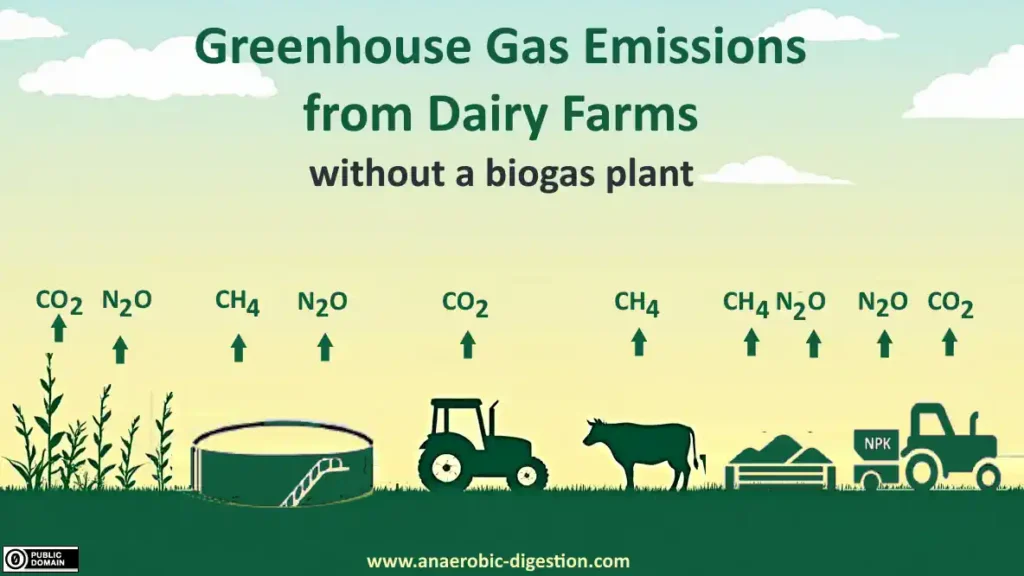
How effective are farm digesters at reducing greenhouse gases?
Farm digesters are a strong tool for cutting greenhouse gas emissions. Generating 1 kWh of electricity from cattle slurry can lower net emissions by 3.27 kg of carbon dioxide. This happens through anaerobic digestion, where microbes break down waste, and biogas is captured instead of released into the air.
They also produce digestate, which replaces synthetic fertilisers. This reduces nitrous oxide emissions caused by chemical fertiliser use. By managing mixed waste more efficiently, farm digesters help create sustainable energy while promoting cleaner agriculture practices.
Additional Environmental Benefits of Farm Digesters
Farm digesters cut waste by turning leftovers into useful products, like fertiliser. They also boost green energy, creating power from things usually tossed aside.
What economic advantages do farm digesters offer farmers?
Farm digesters turn farm waste into valuable energy. This renewable energy can be sold back to the grid, adding income for farmers each month. Anaerobic digestion plants also cut spending on chemical fertilisers by producing natural fertiliser from processed waste.
Using a digester means less money spent on waste disposal too. This boosts financial stability for rural communities while reducing farming costs long term. Dairy farmers especially benefit, as manure is easily transformed into biogas and organic composted material.
Waste becomes profit with the right systems in place.
UK Policy Frameworks and Support for Farm Digesters
The UK government offers various incentives to encourage farm digester adoption. Grants and support schemes aim to boost renewable energy use while cutting emissions.
What policies and support exist for farm digesters?
California backs farm digesters with strong policies. Their goal is to cut greenhouse gases by 40% below 2013 levels by 2030. Investment funds help farmers install anaerobic digestors, reducing methane emissions from manure.
Programmes like the Dairy Digester Research and Development Programme provide grants for digester projects.
The UK promotes renewable sources through subsidies and loans too. Farm digesters qualify for incentives under carbon capture, utilisation and storage (CCUS) schemes. These systems also aid in generating electricity using recycled water or biogas combustion, boosting sustainability efforts nationwide.

Where can I find reliable sources and citations?
The U.S. Environmental Protection Agency is a trusted source for data on farm digesters and emissions. Their studies cover methane reduction, anaerobic lagoons, and emissions comparisons.
Scientific publications also provide detailed insights on codigestion benefits.
Research from Bangor University and the German Energy Department can support policy decisions. They offer information about carbon-neutral practices, fertiliser use, and renewable systems like micro-hydro or solar projects in agriculture.
These sources ensure accuracy when studying environmental impacts or sustainable technologies.
Conclusion
Farm digesters are a game-changer for sustainable farming. They cut methane, turn waste into energy, and offer farmers economic perks. Using them can make farms greener and more efficient without breaking the bank.
With growing support from policies and tech upgrades, their future looks bright. Cleaner air, less waste, more profit – that’s progress worth investing in!
FAQs
1. What are farm digesters, and how do they work?
Farm digesters break down organic waste to produce biogas. The gas can be combusted to generate energy like steam or electricity, while the leftover material is used as fertiliser.
2. Can farm digesters help reduce carbon emissions?
Yes, they can create a carbon-negative impact by capturing methane from waste that would otherwise escape into the air.
3. How does the process involve pellets and pumping?
Pellets made from compressed organic materials can fuel some systems. The liquid by-product is often pumped back onto fields as nutrient-rich fertiliser.
4. Are farm digesters cost-effective for small farms?
They have upfront costs but offer long-term savings through energy production and reduced need for chemical fertilisers. Over time, they unlock profit potential in sustainable farming practices.
What are the Main Components of Farm Digesters?
Farm digesters typically include several distinct elements. They have one or more digester chambers and a slurry preparation facility. Storage areas hold processed slurry while separate spaces collect gas and house mechanical equipment for heating and agitation.
Routine checks and scheduled maintenance prove essential. Operators benefit from clear access to all equipment. Clear design and regular servicing help maintain safety and efficiency in biogas generation.
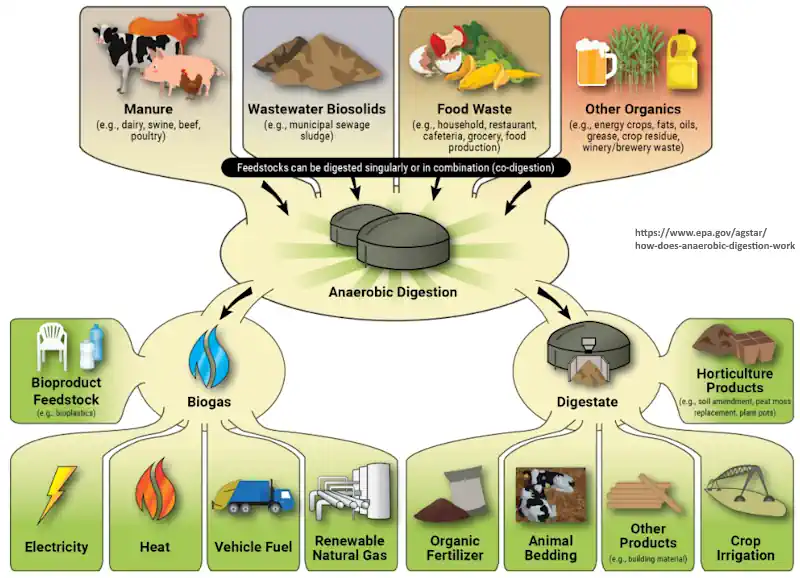
How Anaerobic Digestion (AD) in Farm Digesters Can Reduce Agricultural Methane Greenhouse Gas Emissions
Anaerobic Digestion Plants reduce these emissions using several strategies. Systems trap methane generated during the storage of raw slurry or farmyard manure. Captured methane is then converted into useful energy, which keeps the gas from entering the atmosphere.
- The trapped methane is converted to electricity or heat.
- Nutrients from livestock and organic wastes are recycled. This process cuts the fossil energy required for manufacturing and transporting chemical fertilisers. Recycling also helps lower nitrous oxide emissions.
- Compost fibre produced during digestion reduces reliance on peat in horticulture, saving carbon dioxide emissions linked to peat extraction.
The difference between overall emission savings and those saved by generating electricity from gas produced by energy crops instead of fossil fuels is very significant. The quotation from the book “Farm Digesters”, by Jonathan Letcher, helps illustrate this point.
Anaerobic digestion works by isolating manure from oxygen, stopping the process that leads to methane release13. This technology can reduce atmospheric methane levels by roughly 80%, as shown by field studies1.
Carbon Emissions from Farm Digester Fossil Fuel Combustion Compared with GHG Reduction Achieved During Farm Digestion
When generating 1 kWh, fossil fuels emit about 0.7kg of carbon dioxide on average. Energy crops produce net emissions of 0.45kg. In contrast, using a mixture of slurry and energy crops results in emissions of less than 0.1kg.
References
- ^ https://news.ucr.edu/articles/2025/06/11/california-dairy-tried-capture-its-methane-it-worked
- ^ https://farmonaut.com/blogs/dairy-farming-impact-on-environment-7-key-changes-2025
- ^ https://www.epa.gov/agstar/anaerobic-digestion-dairy-farms
- ^ https://cast-science.org/publication/potential-for-u-s-agriculture-to-be-greenhouse-gas-negative/
- ^ https://www.terrascope.com/blog/what-percentage-of-emissions-come-from-agriculture

